Earlier this month Otago's Professor Neil Gemmell travelled to Scotland to reveal the findings of his environmental DNA study of Loch Ness. Anticipating an avalanche of global media attention, Senior Communications Adviser Mark Hathaway accompanied him, playing his part in spreading the word to, potentially, 4.8 billion people. He writes about the experience for the Otago Bulletin Board.
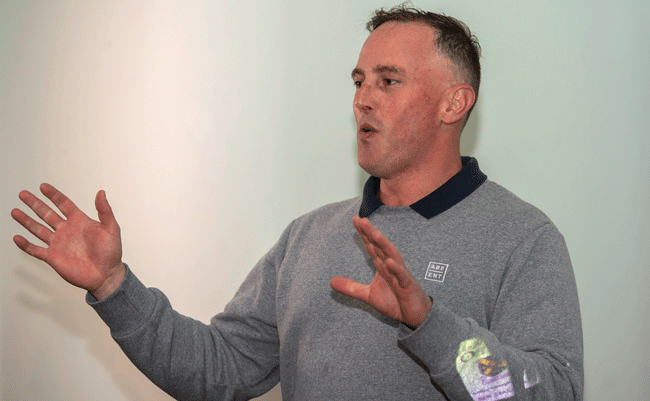
Senior Communications Adviser Mark Hathaway at the media conference in Drumnadrochit. Photo: VisitScotland.
Most of the work I do helping publicise our research can be done from my desk in Otago's Clocktower building.
But when the opportunity came to travel to Scotland to support Professor Neil Gemmell in announcing the findings of his study into environmental DNA (eDNA) in Loch Ness, I knew I could not miss it.
It's not to say I wasn't nervous. I was very nervous.
We knew from last year's huge media interest that any mention of results was going to be another big spike. That was fine with me. What I wasn't so sure about was how the news would be taken by the media and the general public.
Firstly, I needed to talk to Neil to see what it is he would be saying, which essentially came down to: “based on the descriptions from the 1,000 or so sightings of something in the water at Loch Ness, our data supports one of the main explanations of what people have seen – that the monster is a giant eel – and discounts the three other main explanations.”
OK, that sounds like something.
The other three explanations are a dinosaur, a big fish like a catfish or sturgeon, or a shark. Neil hadn't found any DNA to support those. He did find heaps of eel DNA. Lots of it, in every sample from the Loch.
Has anybody every caught a monster-sized eel?
Neil said no.
How big are most European eels?
Neil said around three to six feet.
How big is the monster people say they've seen?
Neil said 12 feet plus.
So, how can you be sure the “monster” is a big eel?
He wasn't sure. He thought it possible the extremes of genetic mutations might produce such a large specimen in such a big population in such a big deep dark place.
Righto, so based on your data and the descriptions from sightings that's the most plausible explanation?
Neil said yep.
OK. I'd love to have him tell me there was some sort of freak monster eDNA found. But that wasn't the case.
The monster factor is what makes this study different to any other I'd dealt with. Arguably, we were dealing with a figment of imagination stemming from more than 1,000 people seeing something in the loch, and a myth developing.
So the task was to deliver findings about the biodiversity of this place in which many people believe a mythical monster exists. As I've said, I was a bit nervous as to how the news would go down.
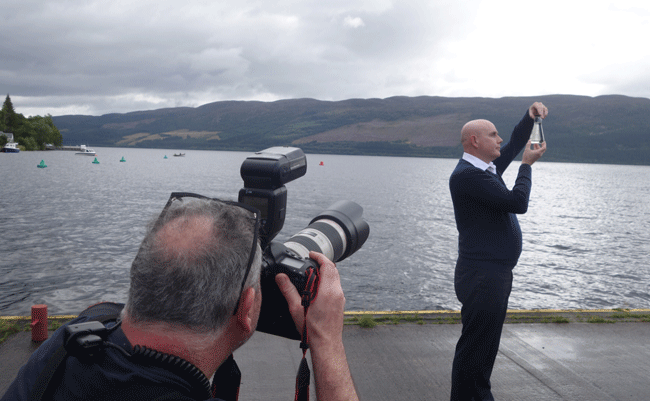
Professor Neil Gemmell with a water sample. Hundreds of samples from Loch Ness were analysed to create a picture of the animals living there.
Two weeks out I sent an invite to media that had covered the study in 2018 to attend a press conference in a fortnight at the small town of Drumnadrochit on the shore of the loch. I added a quote from Neil about the four main theories and the data supporting one of those and discounting the others, but didn't go into detail of dinosaurs and eels, etc. The rest of the invite was basically a where-and-when of the press conference.
With the quote included I was expecting the invite to spark some coverage, but was surprised how far it went. Our monitoring found the invite led to coverage reaching a potential audience of 380 million people.
A lot of reporters commented to me about how much of a tease the invite was, and while I didn't want to overblow the situation, there needed to be a good reason for media to show interest.
For the next fortnight I spent the majority of my time responding to questions from media. Could they have an embargoed copy of the results? Could they have an early interview with Neil? And so on.
Those are all reasonable requests, but in order to cover as many media organisations and spread the word as far as possible, Neil needed to be there to explain his findings and answer questions in one hit. So the answer was always a polite “no, but see you at the press conference.”
There were other factors to sort out. Assembling as much visual material as possible – video and photographs the media could use. The Editor of the University of Otago Magazine, Karen Hogg, helped organise an infographic explaining the giant-eel explanation. MPU provided excellent drone video of our campus.
All this was brought together in a shared drive with a link available in the main media release that would be sent at the same time as the press conference.
Other logistical factors such as the size of the venue were a constant anxiety until the conference itself. Neil had been offered use of the Loch Ness Centre and Exhibition, which is in Drumnadrochit. The Centre had helped during the research phase. I wasn't sure what to expect.
How big is the room?
He reckoned about four times the size of his office.
With the number of requests that had been coming in I wasn't sure if everyone would fit.
Four days before the conference I sent one last reminder to media, plus some video which might help them on the day, and headed to the airport.
I'm the first to admit that the south of New Zealand to the north of Scotland is a long way to go for a press conference. Eventually I made it to Inverness. My suitcase decided to go sightseeing somewhere along the way, and showed up a few days later. Luckily I had most of what I needed in my carry-on.
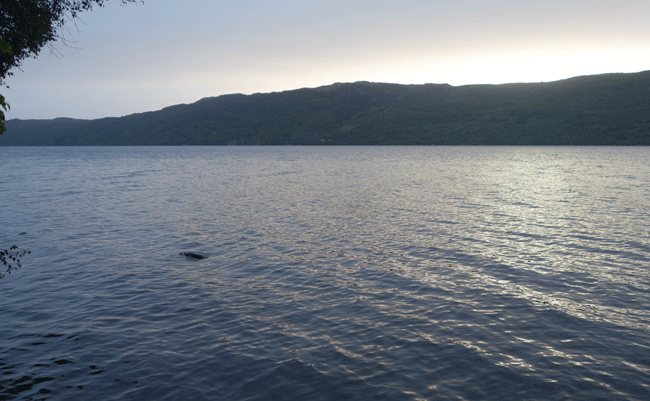
The changeable waters of Loch Ness.
Seeing the loch for the first time, I found myself scanning the surface of the water for monsters. Loch Ness has an interesting atmosphere; the water is an inky dark colour, and its surface changes a lot.
Arriving at Drumnadrochit I was pleased to see Neil and check out the venue. The room was the size of a large living room. I was reasonably sure the media would fit. As a former reporter I had done some cramped press conferences so knew that although a few cameramen would probably grumble (a group of cameramen is jokingly termed “a whinge”), they should be able to make it work.
The night before the press conference I slept about two hours, my head busy with thought.
Finally morning rolled around. Media arrived, and the room started to fill. People kept flowing in. Fortunately they were all good sorts, and as expected they made do.
I introduced myself to the pack, and made sure they were aware livestreams were starting so could they keep profanities to a minimum, then handed it over to the Centre manager for a brief introduction.
Neil was happy and ready to go, so I went to send the media release. I often get a bit nervy sending a media release. Have I attached everything properly? Have I included everyone? Have I spelled my name correctly?
A couple of deep breaths. Send.
A colleague back home messages to say he's got it. Great.
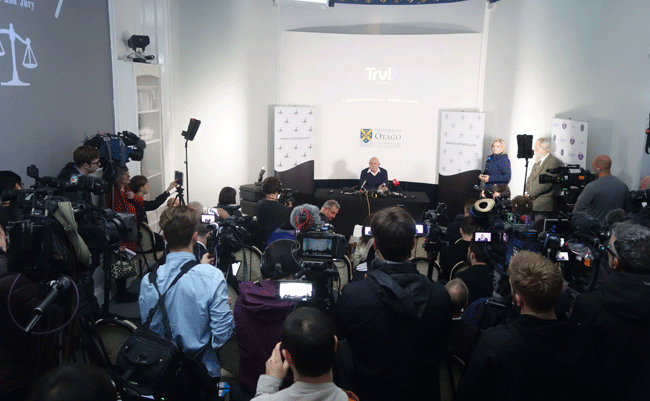
Professor Neil Gemmell keeps his cool under the world's media spotlight.
Back to the conference where Neil is already taking questions. Having interviewed him myself I was confident in his ability to answer the questions informatively and handle the pressure of the moment. As expected, he took it all well and as the questions dried up I thanked the pack.
That was just the beginning of the day. Most crews wanted individual interviews with Neil, so we began working through those for around five hours, with a handful of live TV crosses via Skype to European channels, filmed by me holding Neil's phone.
After an early dinner there were another 10 interviews and crosses, mainly for New Zealand TV and radio morning shows.
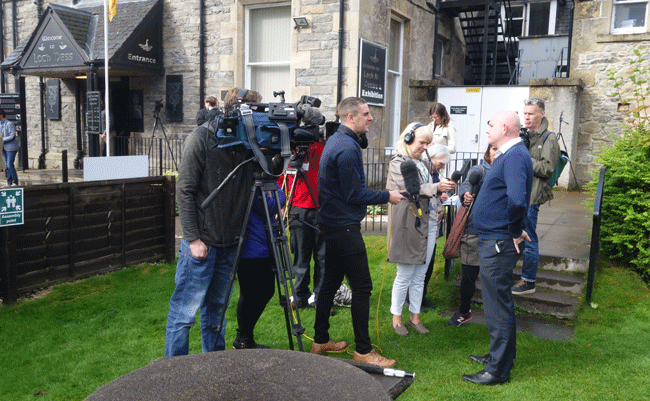
Professor Neil Gemmell maintains his enthusiasm during about 20 follow up interviews.
By 9pm we were finally done for the day. So, to the pub. It was One News reporter Joy Reid's final assignment as Europe Correspondent, and having worked with her and the Newshub reporter in my previous job it was good to catch up and toast a successful day.
Most importantly from my perspective, the media seemed happy with how the day had run. This comes down partly to me keeping things moving and providing as much material as possible, but most importantly it came down to Neil delivering.
I have to tip my hat to Neil, it is not easy to do multiple interviews back to back (he did a lot – I'd say around 20) and for each one was engaging, energetic and informative. The interview requests continue to come in now, and Neil has been great in working through those and spreading the key message of how eDNA provides valuable knowledge about biodiversity of a place.
This story has received the most coverage of any out of the University of Otago. As Neil has mentioned, the monster hunt was the bait, and the science is the hook. His aim has always been to promote eDNA and it's potential for monitoring biodiversity. I'm proud to have played my part in spreading that message.
I'd quietly been hoping we would reach a potential audience of 1 billion people. Our latest tally up shows the story has reached a potential audience of 4.8 billion. If even a small percentage of those people now know about the University of Otago and are now interested in science and eDNA and perhaps want to come here, then that is a great result in my book.
